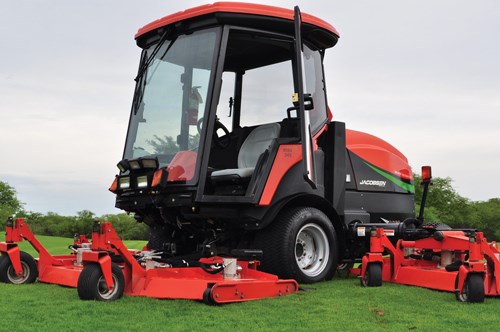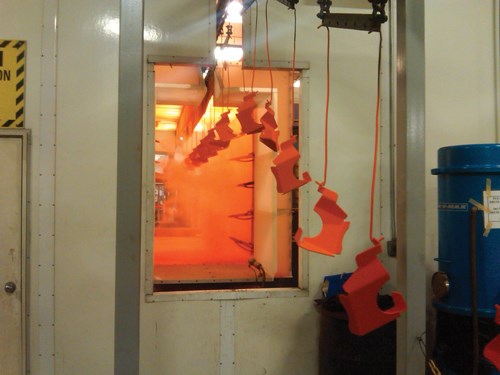Game Planning Your Pretreatment Switch
How golf course equipment maker Jacobsen aced the conversion.
Professional golfers like to size up the course before ever hitting their first drive, spending countless hours studying fairways and green undulations so they know where to place their first shot, their second and eventually putt out, hopefully under par.
It’s called “game management,” and that is what golf course equipment manufacturer Jacobsen did before it started redesigning the pretreatment line at its Charlotte, N.C., manufacturing plant.
It was up to Prashant Omar, Jacobsen’s manager of Manufacturing Engineering and Continuous Improvement, and a team of engineers, maintenance personnel and their supplier to devise a game plan to rid the company’s pretreatment line of iron phosphate and switch to an alternative that would reduce energy costs and cut down on the amount of sludge waste that needed to be routinely hauled from the plant.
“We wanted to have a game plan in place so that things went smoothly,” Prashant says. “We took a look at everything that went into the conversion and tried to anticipate things. Because of that, everything went very well in the end.”
SYSTEM REDESIGN
It wasn’t just changing chemistry; the Jacobsen team worked with suppliers and in-house maintenance staff to redesign the system, adjust and add new plumbing, and then fine-tune the installation to keep assembly lines running.
Jacobsen—which makes a dozen different types of fairway mowers alone—manufactures a full line of commercial-grade turf maintenance equipment at its Charlotte facility. The company’s equipment is used worldwide on golf courses and sports fields, and in municipal applications. Jacobsen’s product portfolio also includes high-quality reel and rotary mowers, aerators, sand rakes and utility vehicles.
The company sells about 250 different products in all, and has 11 assembly lines at the plant, meaning a lot of parts are coming into the pretreatment area to get ready to be painted or powder coated.
“Our products may have as many as 1,000 parts on it,” Prashant says. “They need to be pretreated before coating so that they can withstand the elements. That’s a lot of parts coming through.”
Jacobsen is part of Textron Inc., a multi-industry company that has its hands in the aircraft, defense, industrial and finance businesses. It offers such powerful brands as Bell Helicopter, Cessna Aircraft, Kautex, Lycoming, E-Z-GO, Greenlee and Textron Systems. Jacobsen sells products under the brand names Ransomes, Cushman and its namesake Jacobsen, primarily through a worldwide network of distributors and dealers.
Business is booming for Jacobsen. According to the company’s annual reports, global equipment sales were up almost 13 percent in 2012, and the company posted record growth in the United Kingdom (up 25 percent) and China (up 90 percent).
PRODUCT ROLLOUT
The company continues to roll out new products, including last year’s Eclipse 322 three-wheel-drive riding greens mower, which was enhanced for climbing steep terrains on the golf course. That keeps the pretreatment and coatings lines very busy.
The retooling of the pretreatment line was a task that usually brings angst to most, but Jacobsen’s team gained faith in the process after seeing sister company E-Z-GO in Augusta, Ga., and Ransomes Jacobsen in England take on the project successfully several years ago.
E-Z-GO switched to Chemetall’s Oxsilan, an advanced pretreatment that replaced the traditional iron and zinc phosphate products that the manufacturer had been using. Not only did the conversion save the company from spending a lot of time dealing with sludge issues, but E-Z-GO saw the added benefits of lower operating costs and quicker processing times.
Switching its system over to the Oxsilan, a thin film, multi-metal pretreatment technology, resulted in E-Z-GO using about 30 percent less water than before. The company also is using greener chemistries, which is why Textron is looking to get all its manufacturing operations on the same environmental page.
PLANNING THE CHANGEOVER
Seeing E-Z-GO’s success was enough for Prashant to call in his local Chemetall US, Inc technical sales manager, Chris Keeter, to discuss a changeover and plan for the improvements.
Keeter, who also worked with E-Z-GO on its conversion, says the Oxsilan process is based on silanes that form aqueous solutions through hydrolysis and condensation, or polysiloxanes. He says that during the coating process, the reactive silanol groups can be chemically bonded to the metal, as well as to the paint and powder coating.
Heating during the paint cure cycle further crosslinks the polysiloxanes, creating thin layers in the nanometer range, Keeter says.
“As the Oxsilan film dries, neighboring hydroxyl groups react with each other to form a dense, interpenetrating, crosslinked network that is chemically bound to the metal surface,” he says. “An ultra-thin organic/inorganic coating is formed compared to conventional technologies where crystal layers are deposited.”
The conversion process for the Jacobsen seven-stage spray washer, which was pretreating hot and cold rolled steel, began in July 2012. The existing system began with a heavy duty alkaline cleaner, followed by a rinse. The third stage was an acid pickle to remove the laser cutting scale and the weld smut, followed by another rinse. Then an iron phosphate stage took place, and the entire process closed with a rinse and a dry-in-place final seal.
LOWER HEAT, REDUCED SLUDGE
The biggest motivators for Jacobsen to consider the conversion was to turn off the heat in the iron phosphate stage and to reduce waste removal from the system.
“There was no wastewater treatment at the plant, so they had to haul off any chemical waste because they could not dump it to the drain,” Keeter says. “With the iron phosphate and the dry-in-place system, they were having two tanks that frequently got dumped, and it was rather extensive to charge back up.”
The first four stages of the redesigned line basically stayed the same: alkaline cleaner, rinse, acid pickle and two rinses.
The Oxsilan tank was added, followed by a rinse. The dry-in-place seal was eliminated, as was the iron phosphate tank. The savings were immediate in the reduction of water usage alone.
“Whenever you convert over from a conventional phosphate to an advanced pretreatment, it opens up a whole new window for water conservation,” Keeter says. “Now you can add counter-flows to the rinses without having to worry about carrying phosphate over and out onto the part that would cause a pre-coating condition.”
Previously, Jacobsen’s line was overflowing three stages at about two gallons per minute each, but that has been reduced to just one stage overflowing at two gallons per minute. In addition to the water savings and energy savings from not having to heat the bath, Jacobsen has also found that it is using fewer chemicals overall than it did previously.
“After the first few weeks of getting it up and running, it has really gone smoothly for us,” Prashant says. “We knew what E-Z-GO had experienced with their conversion, and the same has been true for us. There has been a real reduction in energy and water consumption.”
PLUMBING UPGRADES
In addition, the Jacobsen maintenance crews planned and performed plumbing upgrades and modifications, saving time and improving the overall performance of the pretreatment system.
The crew tapped off the water header on the last stage and ran the line back to the rinse before the Oxsilan treatment, so that last rinse water is now spraying before the treatment. The system is a basic counterflow design, recycling and reusing rinse water.
The Jacobsen staff also installed flow meters on the water valves to balance the amount of water in addition to fairly inexpensive filters to help clean the water and adequate size spray nozzles to reduce clogging.
“A mistake most companies make is that when they install counterflow and want to reuse rinse water, they tend to use nozzles that are smaller and therefore clog up,” Keeter says. “But Jacobsen had a plan in place to get the right-sized nozzles and filters, so, at the end of the day, they just pull out the filters, shake them and put them back. It’s pretty easy.”
Prashant says it all goes back to planning the work and then executing the plan. In golf terms, it could be said that Jacobsen hit its greens in regulation with the installation, and came in under par with the energy, water and chemical savings.
“It all came together very well,” Prashant says. “It was very good teamwork.” n
For information on Jacobsen, please visit Jacobsen.com. For information on Chemetall, please call 800-526-4473, or visit ChemetallAmericas.com.
Related Content
Concrete Reinforced Bars Built to Last
Not all corrosion-resistant materials for infrastructure are created equally. Epoxy-coated steel rebar has advantages that other materials used to prevent corrosion do not.
Read MoreMasking Solutions Provider CFS Dramatically Expands Capabilities and Capacity
Custom Fabrication & Supplies (CFS) completed a new plant expansion packing 10 times the capacity into twice the space. It dramatically enhances the supplier’s custom capabilities to provide extremely precise and cost-effective masking solutions.
Read MoreRobots, AI and Superb BMW Surfaces
There isn’t an automotive paint shop in the world that doesn’t have post-paint inspection and defect processing. But BMW is doing this with levels of technology at a plant in Germany that exceed all other paint shops in the world.
Read MoreCoatings Plant Evolves with Market Trends
Expanding its focus from exclusively serving the RV industry, one of this company’s stand-alone coatings plant has successfully extended its services to additional markets.
Read MoreRead Next
Pretreatment for Painting
Better adhesion, enhanced corrosion and blister resistance, and reduced coating-part interactions make pretreatment a must.
Read MoreA ‘Clean’ Agenda Offers Unique Presentations in Chicago
The 2024 Parts Cleaning Conference, co-located with the International Manufacturing Technology Show, includes presentations by several speakers who are new to the conference and topics that have not been covered in past editions of this event.
Read MoreEducation Bringing Cleaning to Machining
Debuting new speakers and cleaning technology content during this half-day workshop co-located with IMTS 2024.
Read More
























